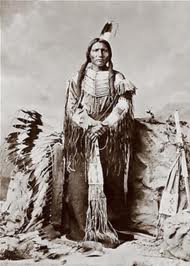Graveyard on Last Stand Hill above Little Big Horn Flats
The battle of Little Big Horn, also known as Custer's Last Stand, was the most famous action of the Great Sioux War. On June 25th and 26th, 1876, the forces of the Lakota, Cheyenne and Arapaho peoples decimated the 7th Cavalry Regiment of the U.S. Army, near the Little Big Horn River in Eastern Montana.
Led by Chief Crazy Horse, 1,800 Native American tribesmen surrounded General Custer and his 5 divisions of troops and gradually annihilated 268 of the soldiers, leaving another 55 wounded. Some deserted and escaped. 136 braves were killed.
Oglala Chief Crazy Horse
The confrontation came after a series of systematic, murderous raids on the native tribes by the U.S. Army and in particular General Custer, who boasted he would drive the "red devils" from their land and slaughter any that resisted. Finally, humiliated and degraded, Crazy Horse and the other Native American Chiefs consulted the wise chief Sitting Bull [Thathanka Iyotanka], who predicted "the soldiers would fall into their camps like grasshoppers from the sky."
Crazy Horse Thasunke Witko [Lakota translation: "his horse is spirited"]
The Chiefs acknowledged their survival was under threat. Grazing lands were being over-run with white settlers and buffalo were being butchered by profiteering white hunters, who skinned the herds they killed for their hides and left the meat to rot on the plains. Their very existence was being threatened and it was time to come together in an all-out assault for survival against the U.S. Army.
Inspired by Sitting Bull's prediction, The Cheyenne, Lakota, Arapaho and Sioux all gathered at Little Big Horn to plan their next move. Army scouts, tracking their movements, reported the gathering of tribes and the Generals ordered a three-pronged attack on the camp. Custer's Calvary divisions arrived on the scene before dawn, but rather than wait for his re-inforcements as planned, he decided to attack and seize the glorious victory for himself.
Modern battle strategists now say Custer's cowardly assault was ill-conceived. He totally under-estimated the strength of the Indians, thinking they would panic, turn and run. And Custer had refused to take the new, deadly Gatling guns with him, a weapon that would have turned the tide of battle.
At dawn, Custer sent a small party of his best men to a culvert at the back of the camp, where hundreds of horses were being tendered by young Indian boys. The soldiers cut the boy's throats and stampeded the horses into the teepees.
The surprised braves leapt from their beds, gathered their horses and mounted a counter attack driving Custer's retreating soldiers up onto Last Stand Hill. The brutal battle lasted all day and it was here that most of the casualties were incurred - on both sides, until Chief Crazy Horse personally led a charge surrounding the soldiers.
Fanciful images of popular culture: General Custer - the "last man standing"
White historians propagate this myth of "red savages descending on the innocent soldiers who fought bravely until on General Custer stood alone, his golden locks flowing in the setting sun." Nothing could be further from the truth.
The Lakota survivors reported Custer's soldiers threw down their weapons and scattered when they realised they were surrounded. The Cheyenne and Sioux warriors ran them down and despatched them routinely with their lances, coup sticks and quits. The warriors fittingly described it as a "buffalo run." Custer was shot in the head and chest and died on the field with the rest.
Arrogant, self-absorbed and egotistical. "Yellow Hair" General George Armstrong Custer
Unfortunately the U.S. Army reprisals that followed Little Big Horn were severe. The American native revolt led directly to the Wounded Knee Massacre, where the white Cavalry stormed into a native village and killed 146 men, women and children, bringing the Indian wars to an end. Sick of the slaughter and starvation, and nearing extinction the Chiefs decided to surrender and settle their remaining peoples on the white government's Indian reservations.
Crazy Horse and other Oglala chiefs, including He Dog Little Big Man and Iron Crow, arrived at the Red Cloud Agency in Nebraska, May 5th, 1877, They met with First Lieutenant William P. Clark to formally surrender. Crazy Horse lived on the Red Cloud reservation for four months until he was falsely accused of a plot to escape and wreak revenge on the U.S. Cavalry.
Under house arrest, for his own protection, and after being transferred from Red Cloud to the Spotted Tail camp, Crazy Horse and his party finally ended up in Camp Robinson Divisional Headquarters. Chief Crazy Horse and Little Big Man were involved in a scuffle with a post guard who stabbed Crazy Horse with his bayonet.
The old Chief died later that night and it is thought that his body was sent to Fort Sheridan to be put on public display, but Crazy Horse was secreted away by his parents to be buried at an undisclosed location at Wounded Knee.





No comments:
Post a Comment